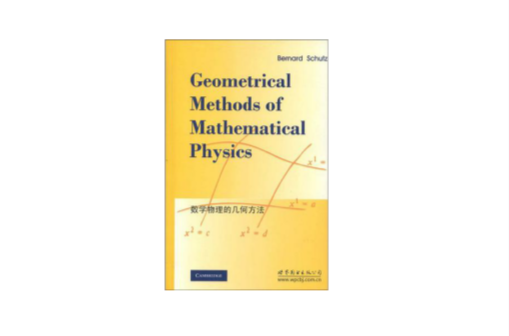《數學物理的幾何方法》是2009年6月由世界圖書出版公司出版的圖書,作者是舒茨。本書主要介紹了有關數學物理的多種幾何方法以及詳細解析。
基本介紹
- 書名:數學物理的幾何方法
- 作者:舒茨
- ISBN:9787510004513
- 頁數:250
- 定價:35.00元
- 出版社:世界圖書出版公司
- 出版時間:2009-6
內容簡介
目錄
1.1 The space Rn and its topology
1.2 Mappings
1.3 Real analysis
1.4 Group theory
1.5 Linear algebra
1.6 The algebra of square matrices
1.7 Bibliography
2 Dffferentiable manifolds and tensors
2.1 Def'mition of a manifold
2.2 The sphere as a manifold
2.3 Other examples of manifolds
2.4 Global considerations
2.5 Curves
2.6 Functions on M
2.7 Vectors and vector fields
2.8 Basis vectors and basis vector fields
2.9 Fiber bundles
2.10 Examples of fiber bundles
2.11 A deeper look at fiber bundles
2.12 Vector fields and integral curves
2.13 Exponentiation of the operator d/dZ
2.14 Lie brackets and noncoordinate bases
2.15 When is a basis a coordinate basis?
2.16 One-forms
2.17 Examples of one-forms
2.18 The Dirac delta function
2.19 The gradient and the pictorial representation of a one-form
2.20 Basis one-forms and components of one-forms
2.21 Index notation
2.22 Tensors and tensor fields
2.23 Examples of tensors
2.24 Components of tensors and the outer product
2.25 Contraction
2.26 Basis transformations
2.27 Tensor operations on components
2.28 Functions and scalars
2.29 The metric tensor on a vector space
2.30 The metric tensor field on a manifold
2.31 Special relativity
2.32 Bibliography
3 Lie derivatives and Lie groups
3.1 Introduction: how a vector field maps a manifold into itself
3.2 Lie dragging a function
3.3 Lie dragging a vector field
3.4 Lie derivatives
3.5 Lie derivative of a one-form
3.6 Submanifolds
3.7 Frobenius' theorem (vector field version)
3.8 Proof of Frobenius' theorem
3.9 An example: the generators ors2
3.10 Invariance
3.11 Killing vector fields
3.12 Killing vectors and conserved quantities in particle dynamics
3.13 Axial symmetry
3.14 Abstract Lie groups
3.15 Examples of Lie groups
3.16 Lie algebras and their groups
3.17 Realizations and representatidns
3.18 Spherical symmetry, spherical harmonics and representations of the rotation group
3.19 Bibliography
4 Differential forms A The algebra and integral calculus of forms
4.1 Definition of volume - the geometrical role of differential forms
4.2 Notation and definitions for antisymmetric tensors
4.3 Differential forms
4.4 Manipulating differential forms
4.5 Restriction of forms
4.6 Fields of forms
4.7 Handedness and orientability
4.8 Volumes and integration on oriented manifolds
4.9 N-vectors, duals, and the symbol
4.10 Tensor densities
4.11 Generalized Kronecker deltas
4.12 Determinants and
4.13 Metric volume elements B The differential calculus of forms and its applications
4.14 The exterior derivative
4.15 Notation for derivatives
4.16 Familiar examples of exterior differentiation
4.17 Integrability conditions for partial differential equations
4.18 Exact forms
4.19 Proof of the local exactness of closed forms
4.20 Lie derivatives of forms
4.21 Lie derivatives and exterior derivatives commute
4.22 Stokes' theorem
4.23 Gauss' theorem and the definition of divergence
4.24 A glance at cohomology theory
4.25 Differential forms and differential equations
4.26 Frobenins' theorem (differential forms version)
4.27 Proof of the equivalence of the two versions of Frobenius theorem
4.28 Conservation laws
4.29 Vector spherical harmonics
4.30 Bibliography
5 Applications in physics A Thermodynamics
5.1 Simple systems
5.2 Maxwell and other mathematical identities
5.3 Composite thermodynamic systems: Caratheodory's theorem B Hamilton/an mechanics
5.4 Hamiltodian vector fields
5.5 Canonical transformations
5.6 Map between vectors and one-forms provided by
5.7 Poisson bracket
5.8 Many-particle systems: symplectic forms
5.9 Linear dynamical systems: the symplectic inner product and conserved quantities
5.10 Fiber bundle structure of the Hamiltonian equations C Electromagnetism
5.11Rewriting Maxwell's equations using differential forms
5.12 Charge and topology
5.13 The vector potential
5.14 Plane waves: a simple example D Dynamics of a perfect fluid
5.15 Role of Lie derivatives
5.16 The comoving time-derivative
5.17 Equation of motion
5.18 Conservation of vorticity
E Cosmology
5.19 The cosmological principle
5.20 Lie algebra of maximal symmetry
5.21 The metric of a spherically symmetric three-space
5.22 Construction of the six Killing vectors
5.23 Open, closed, and flat universes
5.24 Bibliography
6 Connections for Riemnnnian manifolds and gauge theories
6.1 Introduction
6.2 Parallelism on curved surfaces
6.3 The covariant derivative
6.4 Components: covariant derivatives of the basis
6.5 Torsion
6.6 Geodesics
6.7 Normal coordinates
6.8 Riemann tensor
6.9 Geometric interpretation of the Riemann tensor
6.10 Flat spaces
6.11 Compatibility of the connection with volume-measure or the metric
6.12 Metric connections
6.13 The affine connection and the equivalence principle
6.14 Connections and gauge theories: the example of electromagnetism
6.15 Bibfiography
Appendix: solutions and hints for selected exercises
Notation
Index

